Vernalization is the process by which prolonged exposure to cold temperatures triggers flowering in certain plants, ensuring they bloom at the right time in spring. This natural adaptation helps synchronize plant development with favorable environmental conditions, enhancing crop yields and ecosystem balance. Discover how vernalization influences your gardening or farming practices by reading the rest of the article.
Table of Comparison
| Aspect | Vernalization | Photoperiodism |
|---|---|---|
| Definition | Induction of flowering by prolonged cold exposure | Regulation of flowering by day length (light duration) |
| Stimulus | Low temperature (cold treatment) | Light duration (photoperiod) |
| Plant Response | Flowering promoted after cold period | Flowering triggered by specific day length (short-day or long-day) |
| Examples of Plants | Wheat, Barley, Biennial plants | Spinach, Tobacco, Chrysanthemum |
| Biological Mechanism | Epigenetic changes regulating flowering genes | Phytochrome-mediated light perception affecting flowering time |
| Function | Ensures flowering after winter cold | Synchronizes flowering with appropriate season based on daylight |
Introduction to Vernalization and Photoperiodism
Vernalization is the process by which exposure to prolonged cold temperatures triggers flowering in certain plants, ensuring they bloom during favorable conditions. Photoperiodism refers to a plant's physiological response to the length of day or night, regulating flowering based on light duration. Both mechanisms are crucial for synchronizing plant reproductive cycles with seasonal environmental changes.
Defining Vernalization: Key Concepts
Vernalization is the process whereby exposure to prolonged cold temperatures induces flowering in plants, ensuring reproductive development occurs during favorable conditions. This physiological response involves epigenetic modifications that activate flowering genes after a specific chilling period. Distinct from photoperiodism, vernalization does not depend on day length but on the accumulation of cold exposure to trigger flowering pathways.
Understanding Photoperiodism in Plants
Photoperiodism in plants regulates flowering and growth cycles based on the duration of light and darkness, influencing critical developmental stages such as seed germination and bud formation. Unlike vernalization, which requires exposure to prolonged cold to trigger flowering, photoperiodism depends on detecting specific day lengths to synchronize reproductive processes with favorable environmental conditions. Key photoreceptors like phytochrome and cryptochrome enable plants to measure light duration, optimizing adaptation and survival across diverse ecosystems.
Mechanisms Behind Vernalization
Vernalization involves the physiological process where prolonged exposure to low temperatures triggers flowering in certain plants by epigenetically silencing the floral repressor gene FLC (FLOWERING LOCUS C). This cold-induced epigenetic modification allows the stable transition from vegetative to reproductive growth when favorable temperatures return. In contrast, photoperiodism regulates flowering through the perception of day length, mediated by the CONSTANS (CO) gene and the circadian clock, aligning reproductive development with seasonal light cycles.
How Photoperiodism Regulates Plant Development
Photoperiodism regulates plant development by detecting changes in day length through phytochrome and cryptochrome photoreceptors, enabling plants to time flowering and other growth stages accurately. This mechanism influences critical processes such as flowering initiation, seed germination, and bud dormancy by modulating gene expression in response to specific light durations. Photoperiodic responses optimize reproductive success by aligning development with favorable environmental conditions.
Vernalization vs Photoperiodism: Main Differences
Vernalization is the process by which exposure to prolonged cold induces flowering in plants, while photoperiodism is the response to the length of day or night to trigger flowering. Vernalization requires a specific period of low temperatures to activate flowering genes, whereas photoperiodism depends on light duration sensed by phytochrome and cryptochrome pigments. These mechanisms often interact but differ fundamentally in environmental cues, temperature for vernalization and light for photoperiodism, regulating plant development.
Examples of Plants Requiring Vernalization
Wheat, barley, and sugar beet are prime examples of plants requiring vernalization to initiate flowering, as exposure to prolonged cold temperatures triggers their developmental transition. Biennial plants like carrots and cabbage also depend on vernalization to complete their life cycles, ensuring flowering occurs only after winter. In contrast, photoperiodism governs flowering in plants such as spinach and tobacco, which respond primarily to day length rather than cold exposure.
Photoperiodic Responses: Short-day vs Long-day Plants
Photoperiodic responses in plants are primarily categorized into short-day and long-day types, which regulate flowering based on the length of night rather than day. Short-day plants require uninterrupted darkness longer than a critical duration to initiate flowering, such as the poinsettia, while long-day plants flower when nights are shorter than a critical length, exemplified by spinach. Understanding these photoperiodic mechanisms is crucial for optimizing agricultural practices and breeding programs to control flowering times effectively.
Agricultural Importance of Vernalization and Photoperiodism
Vernalization and photoperiodism are crucial for optimizing crop yields by regulating flowering time in response to environmental cues. Vernalization, the exposure to prolonged cold, enables winter crops like wheat and barley to flower in spring, ensuring proper development and harvest. Photoperiodism, the sensitivity to day length, controls flowering in plants such as soybeans and rice, allowing adaptation to geographic latitudes and seasonal changes for maximizing agricultural productivity.
Future Research and Applications
Future research on vernalization and photoperiodism aims to enhance crop adaptation to climate change by deciphering the genetic and molecular mechanisms controlling flowering time. Advances in CRISPR and gene editing technologies enable precise manipulation of vernalization and photoperiod pathways, facilitating the development of crop varieties with optimized growth cycles for diverse environments. Integrating phenomic data and environmental modeling will improve predictive breeding strategies, accelerating crop resilience and yield under shifting seasonal patterns.
Vernalization Infographic

 libterm.com
libterm.com